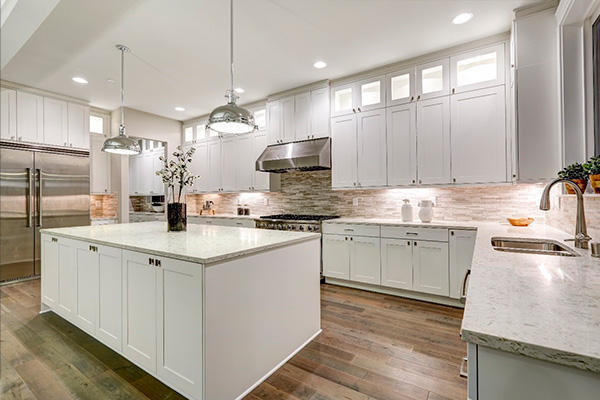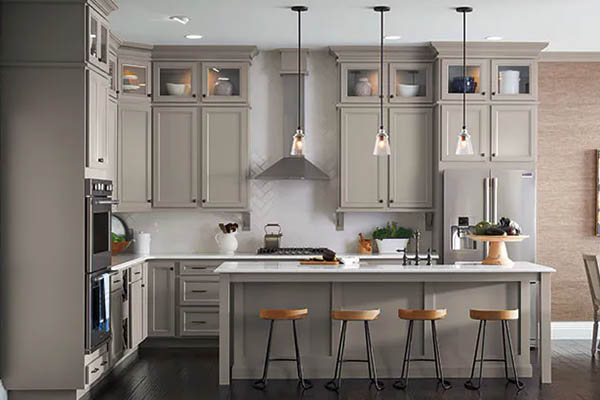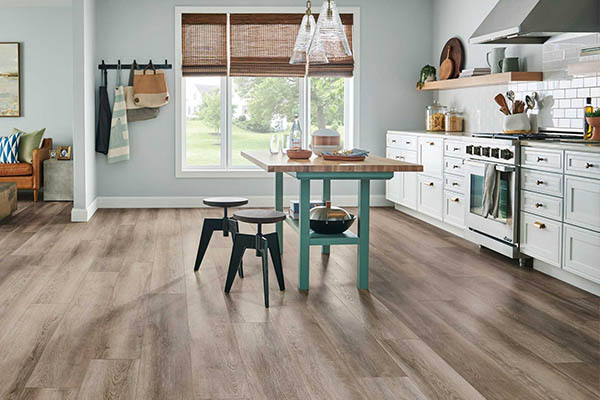Kitchen cabinets: the most popular questions answered
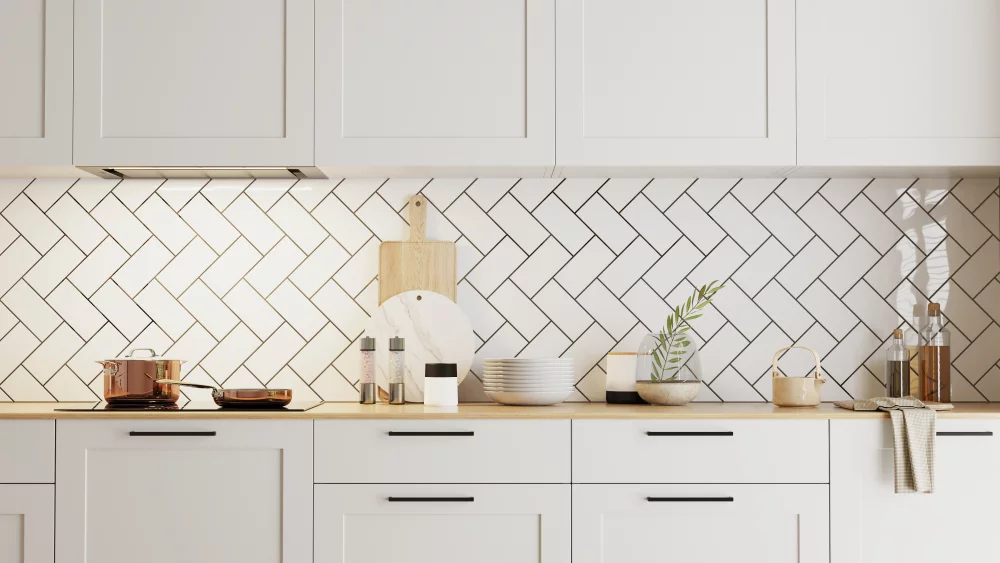
Kitchen cabinets are a type of furniture used in kitchens to store food, dishes, and other cooking supplies. They can be made of various materials, including wood, metal, or laminate, and come in many different styles and designs. Kitchen cabinets can be floor-mounted, wall-mounted, or even suspended from the ceiling, depending on the kitchen’s design and the user’s needs.
What is considered to be the top choice for kitchen cabinet material?
The best kitchen cabinet material depends on your preferences, budget, and the look you want in your kitchen. The following is a compilation of some of the most popular materials utilized for kitchen cabinets, including their respective benefits and drawbacks:
Wood: Wood is frequently utilized in kitchen cabinets due to its strength and aesthetic appeal. Common choices among hardwoods are maple, cherry, and oak, while pine is a popular option among softwoods.
- Pros: Warm and natural look, durable, can be stained or painted, good value for money.
- Cons: Can absorb moisture, requiring regular maintenance, prone to warping and splitting.
Laminate: Laminate is an economical choice that requires minimal upkeep and is easy to clean.
- Pros: Inexpensive, low upkeep, ample color and pattern options, simple to clean.
- Cons: Edges and seams prone to peeling and chipping, less durable than other materials.
Metal: Metal cabinets are durable and offer a modern, sleek look.
- Pros: Durable, easy to clean, moisture-resistant, fire-resistant, stain-resistant.
- Cons: Expensive, prone to dents and scratches, noisy when moving items in and out.
Thermofoil: Thermofoil is a budget-friendly alternative that offers resistance to moisture and requires minimal cleaning effort.
- Pros: Low-cost, low-maintenance, moisture-resistant, and easy to clean.
- Cons: Prone to peeling and chipping, less durable than other materials.
Particleboard: Particleboard is an inexpensive option for cabinet boxes.
- Pros: Inexpensive, lightweight, and easy to work with.
- Cons: Not as durable as other materials, prone to warping and splitting if it gets wet.
MDF: MDF is a consistent and stable material frequently utilized in premium cabinets.
- Pros: Uniform and stable, easy to paint or stain.
- Cons: Prone to swelling or warping if it gets wet; not as durable as solid wood.
The ideal material for kitchen cabinets ultimately depends on personal needs, tastes, and financial constraints. It's essential to carefully consider all of your options and choose a material that will meet your specific needs and provide the look and functionality you want in your kitchen.
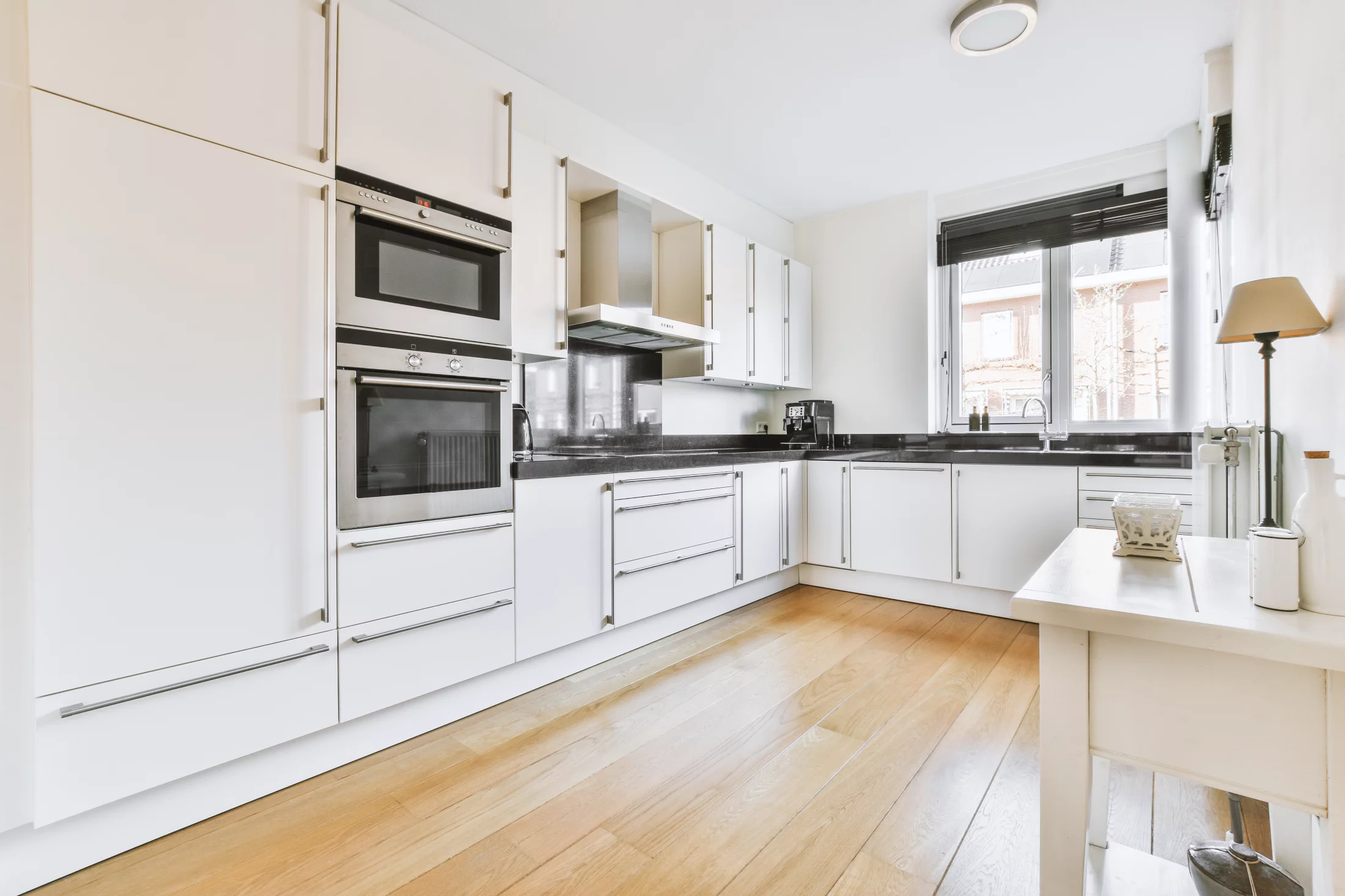
How much do kitchen cabinets cost?
The cost of kitchen cabinets can fluctuate widely due to a range of factors, including the material, kitchen size, and style and quality of the cabinets. On average, you can expect to spend anywhere from $4,000 to $20,000 or more for a complete kitchen cabinet set, with most homeowners spending between $10,000 and $15,000.
Here are approximate figures for various types of kitchen cabinets:
- Stock cabinets: Stock cabinets, which are pre-made cabinets that are readily available, typically cost between $75 and $400 per linear foot.
- Semi-custom cabinets: Semi-custom cabinets offer a wider range of options and customization than stock cabinets, but they are still pre-made. They typically cost between $150 and $1,000 per linear foot.
- Custom cabinets: Custom cabinets are made to order, with every aspect of the design customized to meet the specific needs and preferences of the homeowner. Custom cabinets can cost anywhere from $500 to over $1,500 per linear foot.
It's important to keep in mind that these are rough estimates and that the final cost of your kitchen cabinets will depend on the specific materials, finishes, and features you choose. Labor and installation costs, which can vary widely, should also be taken into account.
How do I measure for kitchen cabinets?
The process of measuring for kitchen cabinets involves taking precise measurements of the area where the cabinets will be installed, including the height, width, depth, and any obstacles or unusual shapes. Here are the steps to measure for kitchen cabinets:
- Measure the height: Measure the height of the area where the cabinets will be installed, including any soffits or bulkheads. Make sure to measure from the floor to the ceiling at the tallest point.
- Measure the width: Measure the width of the wall where the cabinets will be installed, including any obstructions like windows or doors. Measure from
- end of the wall to the other, and make sure to measure at several points to ensure accuracy.
- Measure the depth: Measure the depth of the area where the cabinets will be installed, including the distance from the wall to the front of the cabinets. This measurement is essential to ensure that the cabinets will fit in the space and won't interfere with other items in the kitchen, such as appliances or countertops.
- Account for obstructions: Make a note of any obstructions in the space, such as electrical outlets, pipes, or beams, and make sure to include these measurements in your final calculations.
- Make a rough sketch: Once you have taken all of the measurements, create a rough sketch of the kitchen and label each measurement. This step helps you to visualize the space and ensure the accuracy of all measurements.
It's important to be as accurate as possible when measuring for kitchen cabinets, as even small inaccuracies can result in cabinets that don't fit properly or cause other problems. Consider having a professional measure the space if you need help with how to measure it accurately.

How do I choose the right color and finish for my kitchen cabinets?
Choosing the right color and finish for your kitchen cabinets can be a personal and important decision that can impact your kitchen’s overall look and feel. Here are some tips that may help you:
- Consider your kitchen's style and existing features: Choose a color and finish that complement the overall style of your kitchen, including the flooring, countertops, and wall color.
- Think about natural light: Consider the amount of natural light your kitchen receives, as this can impact how the color appears.
- Pick a neutral color: Neutral colors like white, gray, and beige are versatile and timeless, making them a good choice for a kitchen. They also make a small space look larger.
- Experiment with texture: Experiment with different textures and finishes to add interest to your kitchen. A high-gloss finish can make a space feel modern and sleek, while a matte finish can create a softer, more organic look.
- Take samples home: Before making a final decision, take home paint samples or cabinet door samples to see how the color and finish look in your kitchen under different lighting conditions.

What is the difference between custom and stock kitchen cabinets?
Custom cabinets and stock cabinets are two options for kitchen cabinetry. The primary distinction between them lies in the degree of customization and the production timeline.
- Custom Cabinets: Custom cabinets are manufactured to your specifications, designed, and constructed to fit the precise dimensions and requirements of your kitchen. They offer complete customization options in size, style, material, finish, and hardware. Custom cabinets can take longer to produce and are often more expensive than stock cabinets.
- Stock Cabinets: Stock cabinets are pre-manufactured and stored in a warehouse, ready to be purchased and installed. They have limited customization options and come in standard sizes and finishes for a quick and budget-friendly option. Stock cabinets are usually less expensive and quicker to install than custom cabinets, as they don't require the time and effort involved in custom design and manufacturing.
Both custom and stock cabinets have advantages and disadvantages, and the optimal choice for you will depend on your budget, schedule, and personal design preferences. If you have a unique kitchen space or specific design vision, custom cabinets may be the best choice. Stock cabinets may be a viable choice if you're seeking a faster and more affordable option.
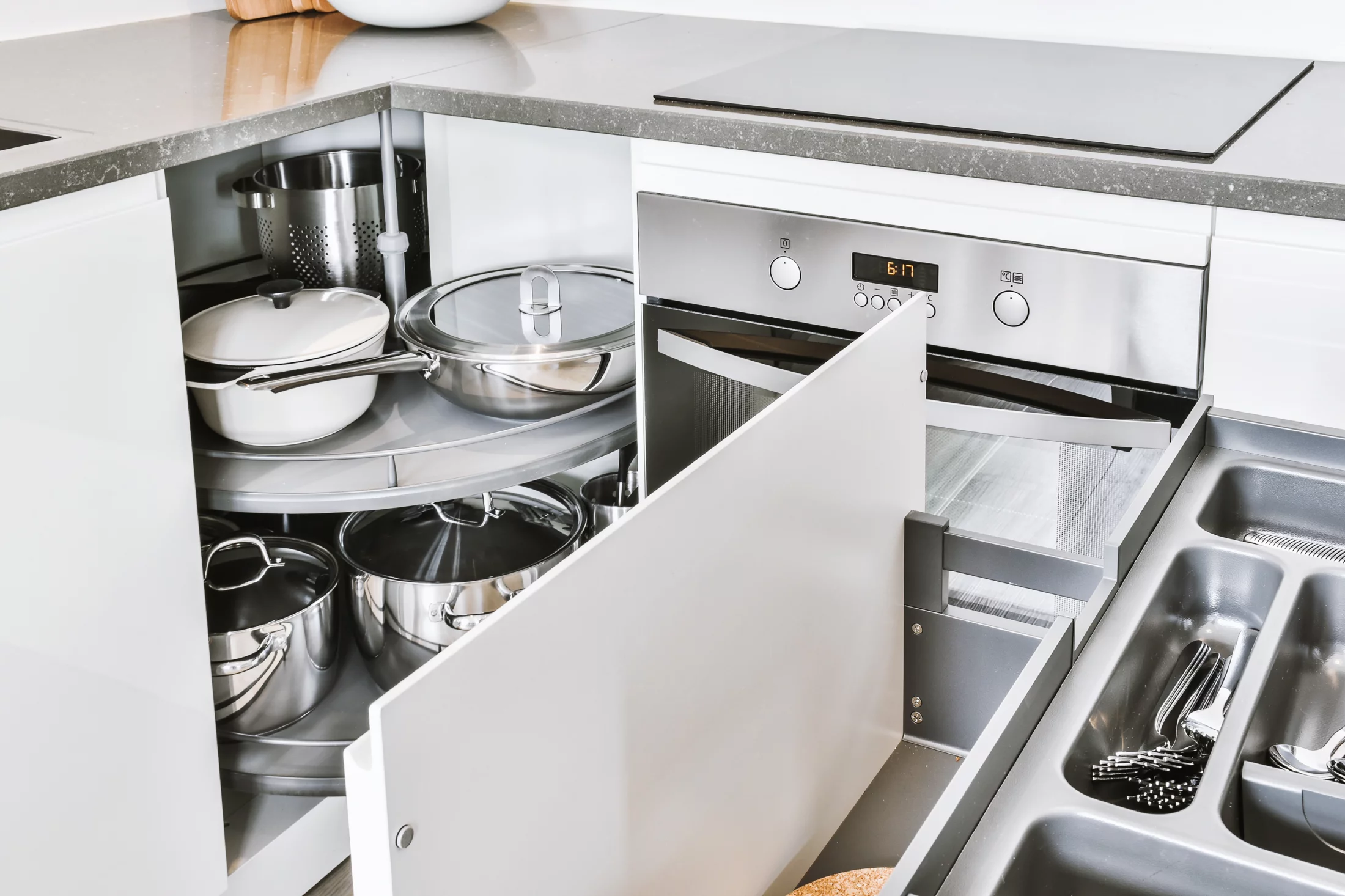
How do I choose the right cabinet hardware?
Choosing the right cabinet hardware can add the finishing touch to your kitchen and significantly impact the overall look and feel of your cabinets. Here are some tips to help you choose the right cabinet hardware:
- Consider the style of your cabinets: Your chosen hardware should harmonize with the style of your cabinets and kitchen design as a whole.
- Think about functionality: Consider the type of cabinets you have and how you use them. For example, if you have large cabinets with heavy doors, you may want to choose hardware with a sturdy, solid feel.
- Decide on a finish: Choose a finish that complements the rest of your kitchen's hardware and fixtures, such as the faucet and light fixtures. Common finishes include brushed nickel, chrome, and oil-rubbed bronze.
- Consider the size: Consider the size of your cabinets and the size of the hardware you choose. Make sure the hardware is proportional to the size of the cabinet.
- Think about the shape: Choose a hardware shape that complements the overall design of your cabinets. Popular shapes include knob, handle, and bar pull.
- Budget: Hardware prices can vary, so it is important to consider your budget when making a choice.
Keep in mind the appropriate cabinet hardware can have a considerable effect on the overall appearance and atmosphere of your kitchen. Take time to choose hardware that fits your personal style and complements your cabinets and kitchen design.
What are some popular cabinet door styles and finishes?
The cabinet door style and finish can greatly influence the appearance and ambiance of your kitchen. The following are some of the most widespread cabinet door styles and finishes:
Door Styles:
- Shaker: A simple, clean design with a recessed panel and minimal embellishments.
- Raised panel: A traditional style with a raised center panel and a contoured edge.
- Flat panel: A contemporary style with a flat center panel and a simple frame.
- Beadboard: A casual style with vertical grooves that resemble a beadboard panel.
- Louvered: A relaxed style with horizontal slats that allow for ventilation.
Finishes:
- Paint: A smooth, even finish that can be customized with any color.
- Stain: A transparent or semi-transparent finish highlighting the wood’s natural grain.
- Glaze: A translucent finish that adds depth and character to the cabinets.
- Distressed: A unique finish that mimics the look of an aged, weathered cabinet.
- High-gloss: A smooth, reflective finish that creates a modern, sleek look.
Ultimately, the right door style and finish for your kitchen cabinets will depend on your personal style and the look you want to create in your kitchen. It's recommended to take home samples and see how they look in your kitchen under different lighting conditions to make an informed decision.
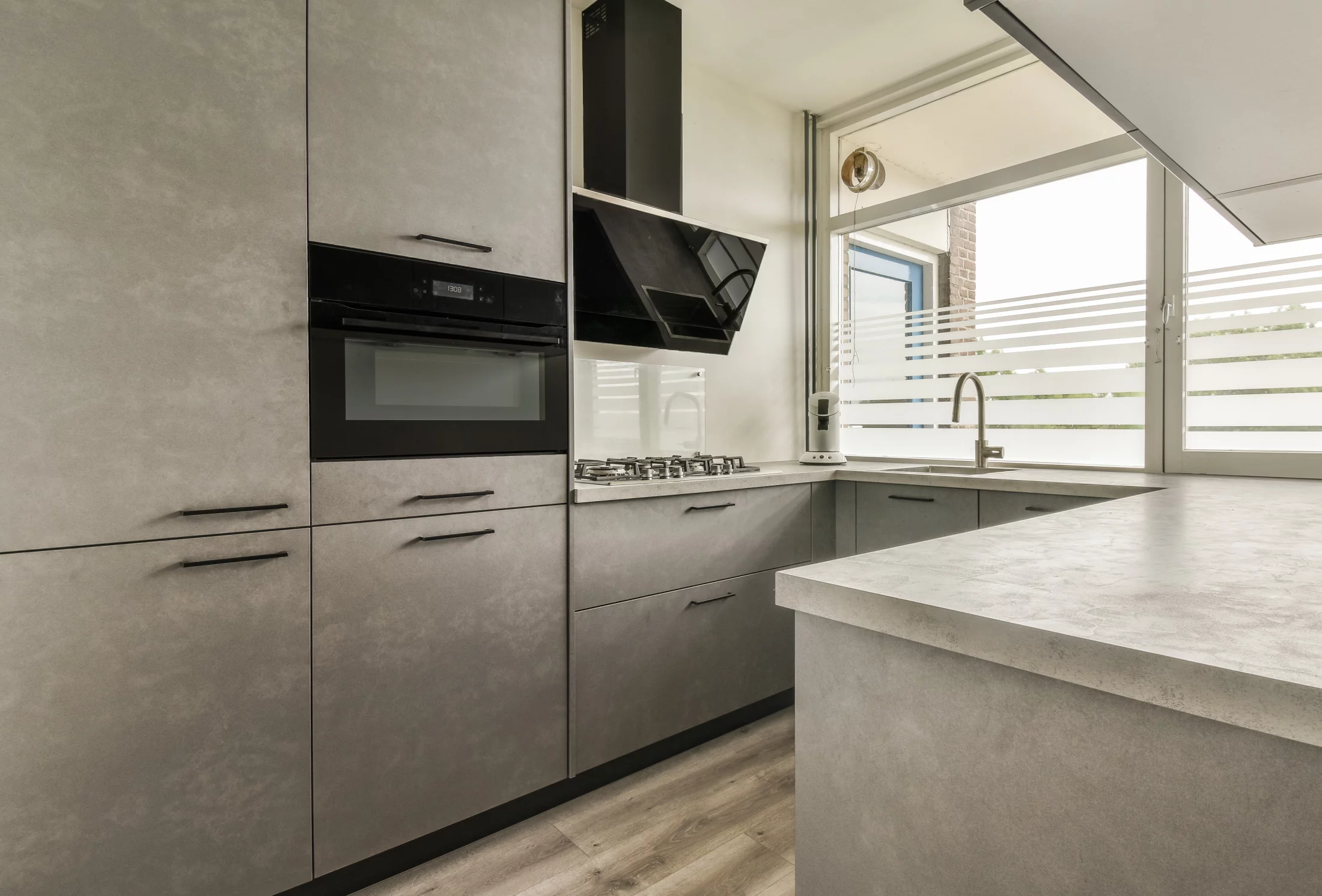
What is the standard height for kitchen cabinets?
The typical height of kitchen cabinets is 36 inches from the floor to the top of the counter. This standard height is designed to accommodate most people's needs and is suitable for most kitchen layouts. However, the standard height may vary based on individual preferences and needs, as well as the height of the ceiling in the kitchen.
For example, some people prefer a higher cabinet height, such as 42 inches, to accommodate tall items like stand mixers and stockpots. On the other hand, those who are shorter or have mobility issues may prefer a lower cabinet height, such as 34 inches, to make reaching items easier.
In any case, it's recommended to consider your own needs and preferences when choosing the height of your kitchen cabinets and to consult a professional kitchen designer for guidance.
How can I effectively use my limited kitchen cabinet storage space?
If you have limited kitchen cabinet space, there are several strategies you can use to maximize your storage and make the most of your cabinets:
- Utilize vertical space: Make use of the vertical space in your cabinets by using stackable or tiered organizers, such as cookie sheets, cutting boards, and pots and pans.
- Install pull-out shelves: Pull-out shelves can make it easier to access items at the back of your cabinets, especially those in deep or hard-to-reach areas.
- Use cabinet door organizers: Cabinet door organizers are a great way to add extra storage for items like spices, cans, and condiments.
- Invest in multi-functional furniture: Consider investing in furniture items that serve multiple purposes, such as a kitchen island with built-in storage or a table with built-in shelves.
- Consider open shelving: Open shelving can be a great way to add extra storage and display space while keeping items within easy reach.
- Make use of the wall: Install hooks, racks, and shelves on the wall to keep frequently used items within easy reach.
- Get rid of unused items: Regularly go through your cabinets and remove any items you no longer use or need.
Using these strategies, you can make the most of your limited kitchen cabinet space and create a more organized and functional kitchen.

Can I install kitchen cabinets myself, or should I hire a professional?
Installing kitchen cabinets can be a challenging DIY project, especially if you are not experienced with carpentry, electrical, and plumbing work. While it's possible to install kitchen cabinets yourself, it's recommended to consider hiring a professional for several reasons:
- Experience: Professional cabinet installers have the experience and skills to properly measure and install cabinets and deal with any unexpected issues that may arise during the installation process.
- Efficiency: Professional cabinet installers have the tools and equipment to efficiently and accurately install cabinets, saving you time and effort.
- Quality: Professional cabinet installers can ensure that your cabinets are properly aligned and level and that the doors and drawers function smoothly.
- Safety: Installing kitchen cabinets can involve heavy lifting, electrical work, and plumbing connections, which can be dangerous for those who are not experienced or equipped with the necessary tools and safety gear.
- Warranty: Installing cabinets incorrectly can void the manufacturer's warranty and result in costly repairs or replacements.
Overall, while you may be able to save money by installing kitchen cabinets yourself, the peace of mind and quality of work that a professional can provide is well worth the investment. If you require more clarity on your capacity to install kitchen cabinets, it is advisable to seek the advice of a professional to determine the optimal approach.

